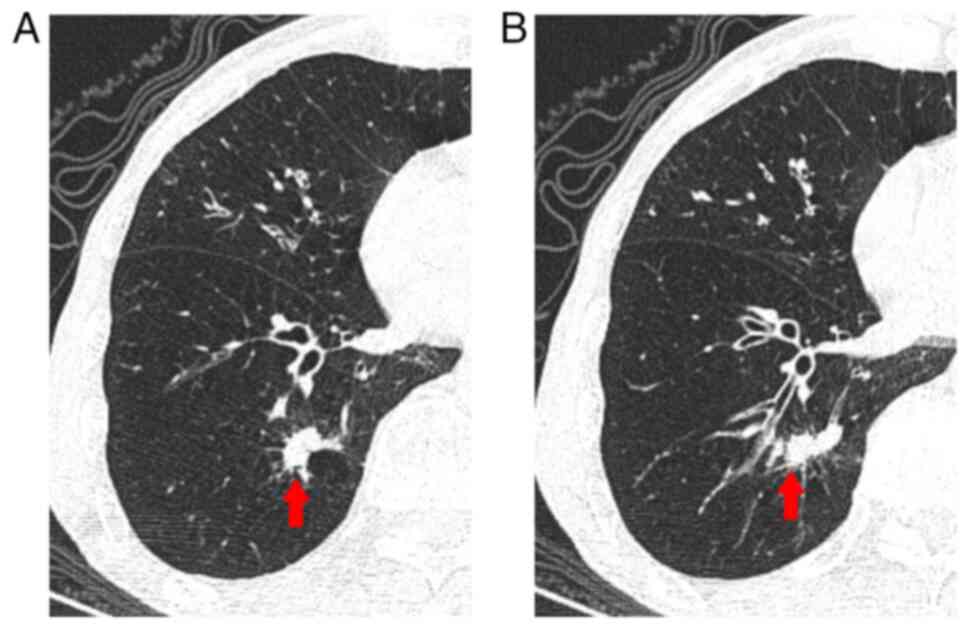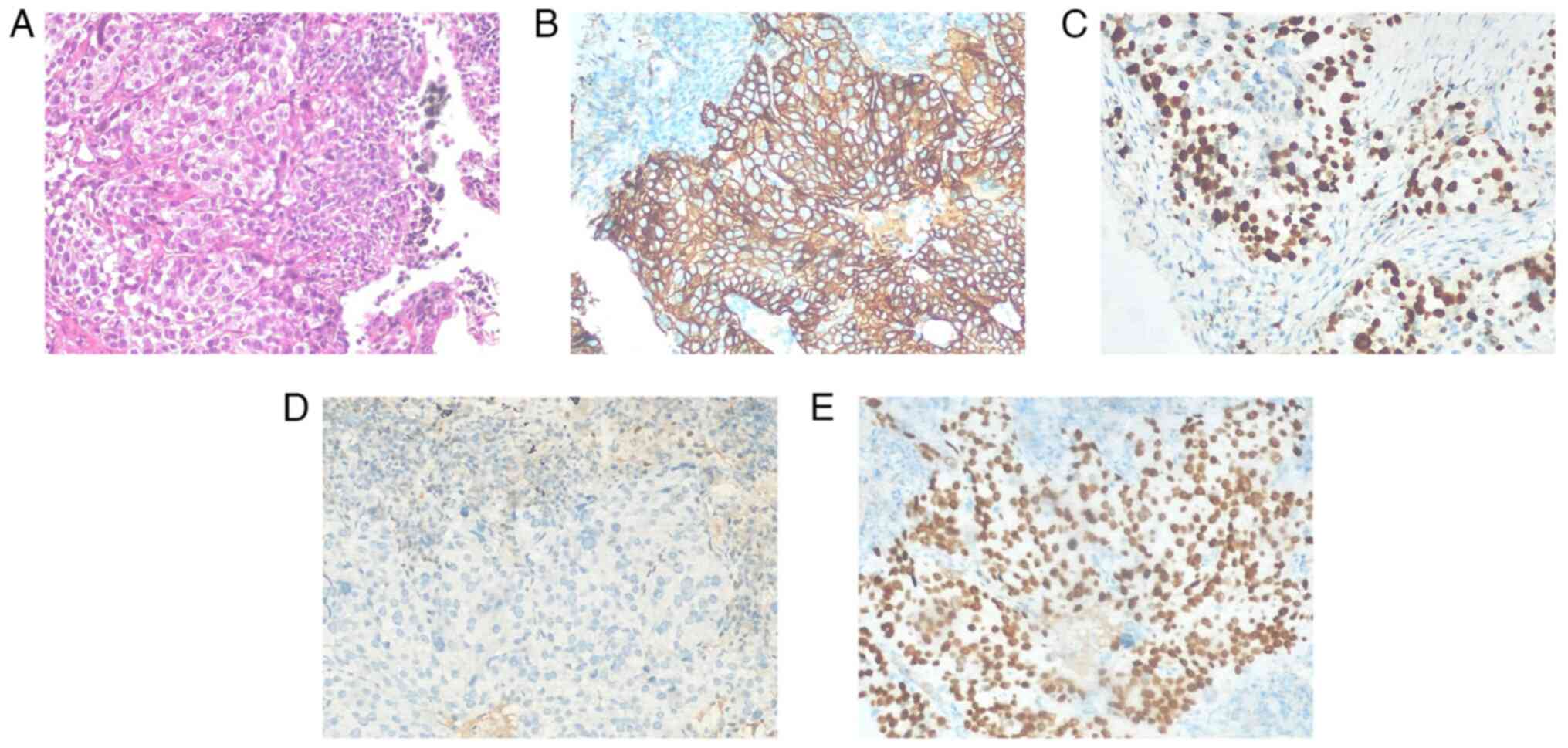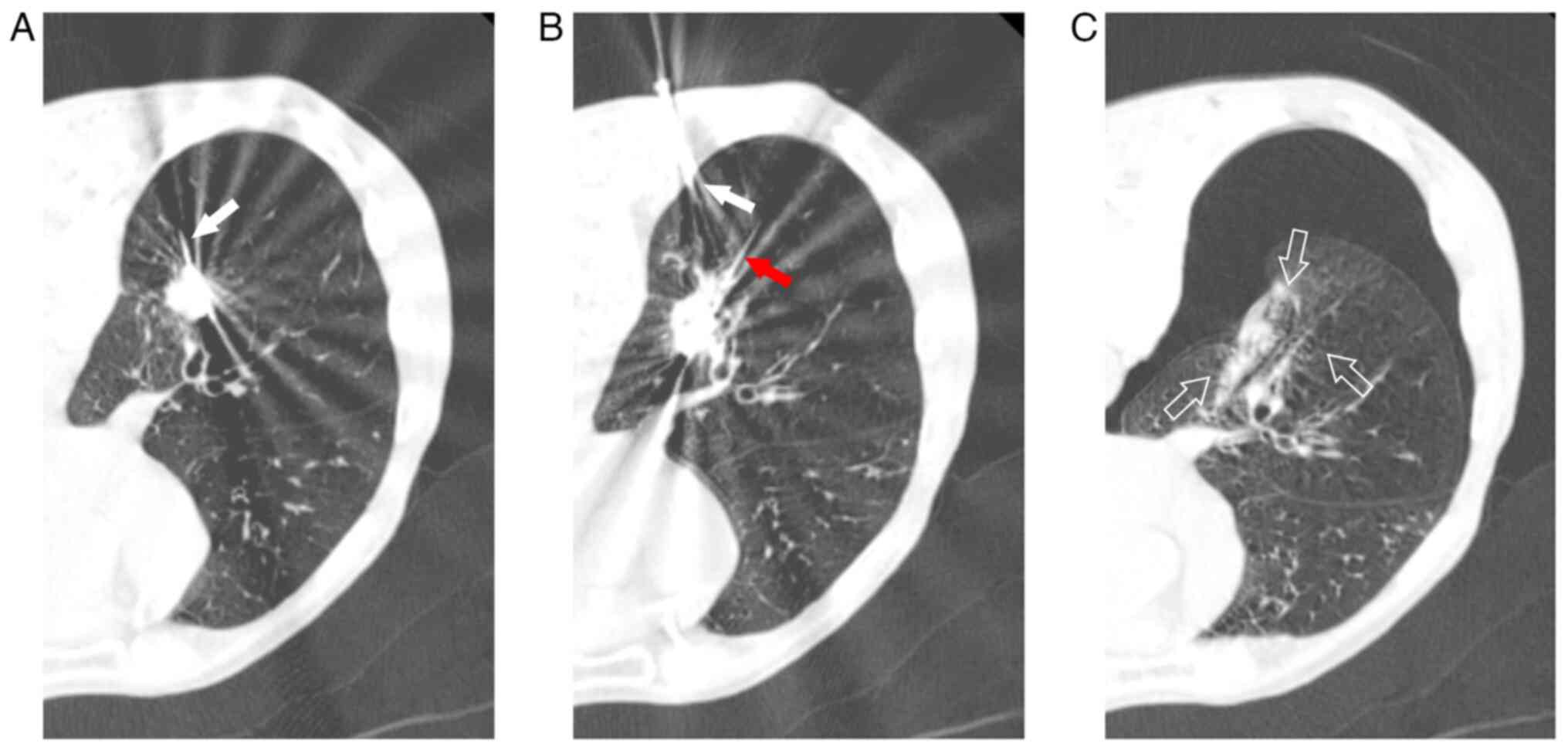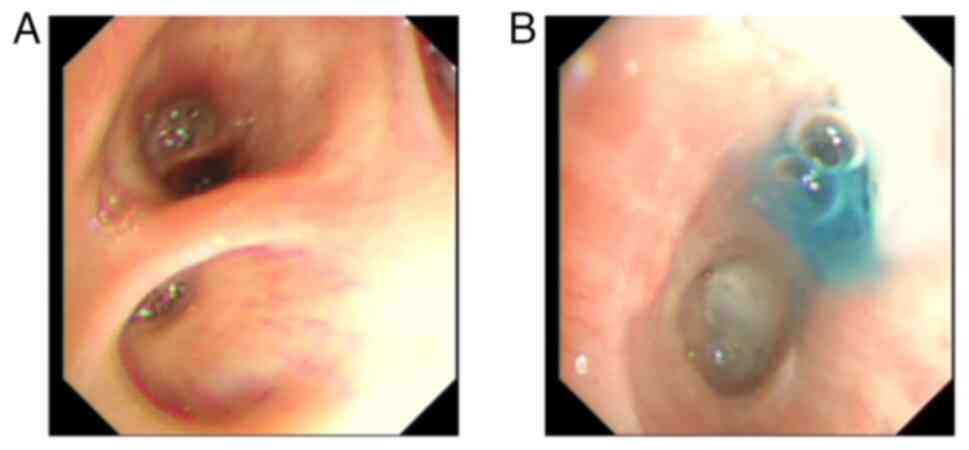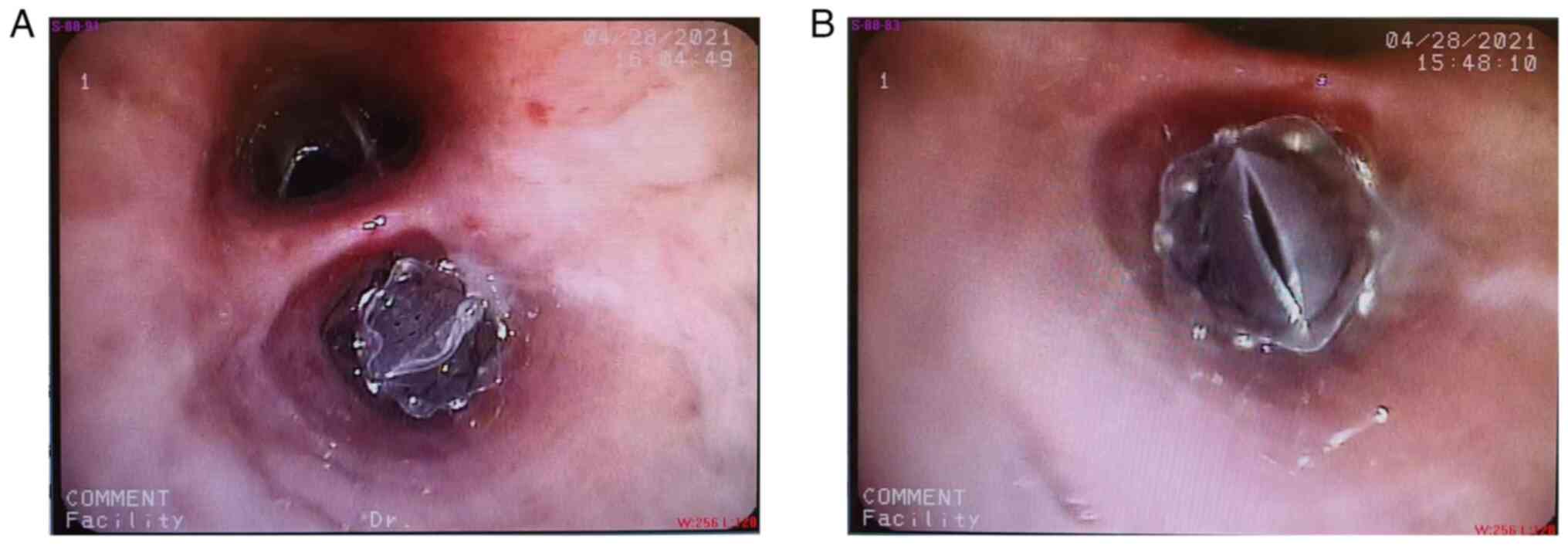Management of bronchopleural fistula after microwave ablation of lung tumor: A case report and literature review
- Authors:
- Published online on: September 30, 2024 https://doi.org/10.3892/etm.2024.12732
- Article Number: 443
-
Copyright: © Meng et al. This is an open access article distributed under the terms of Creative Commons Attribution License.
Abstract
Introduction
Percutaneous lung tumor ablation, which includes methods such as radiofrequency ablation (RFA), microwave ablation (MWA) and cryoablation, is considered as a safe and effective treatment for several inoperable patients with non-small cell lung cancer (NSCLC) or lung metastasis (1). Despite the advantage of reduced trauma, percutaneous lung tumor ablation is still an invasive procedure that can be accompanied by several complications. One of the rarest, but yet most severe, complications is bronchopleural fistula (BPF), with an incidence rate of 0.4-2.0% and a high mortality rate of up to 20% (2-4). To deepen our insights into this complication, the present study reported the case of a patient with BPF following percutaneous microwave ablation (MWA). A statement that the ethics committee reviewed the application and decided that no ethics approval was needed due to the nature of the study being that of a case study would be appropriate. In the present study, the patient with primary lung cancer choose to undergo microwave ablation due to poor lung function and inability to tolerate surgery. Following MWA, BPF, severe lung infection and empyema were reported. Currently, there is no consensus or optimal treatment strategy for BPF. Therefore, only a few studies on the treatment of BPF by endobronchial unidirectional valve (EBV) implantation have been conducted (5-7). The current case study aimed to provide novel insights into the treatment of BPF using EBV.
Case presentation
A 73-year-old man was admitted to the Shaoxing Second Hospital (Shaoxing, China) due to a nodule in the lower lobe of the right lung. Chest computed tomography (CT) scan revealed a 22x10 mm2 irregular solid nodule in the same area (Fig. 1A and B). The patient had a history of complicated chronic bronchitis, emphysema and hypertension, with well-controlled blood pressure. In addition to this emaciated appearance, the physical examination results were non-specific, with a body mass index of 16.4 kg/m2. Pulmonary function analysis indicated that the mixed ventilation dysfunction was mainly obstructive, while the pulmonary diffusion function was severely decreased. A forced expiratory volume in one second [FEV1(L)] of 1.01, accounting for 34.8% of the expected value. In addition, the maximal voluntary ventilation (MVV) value was 29.6 l/min, accounting for 26.1% of the expected value. Additionally, the laboratory tests revealed mild anemia (hemoglobin levels, 103 g/l; normal range, 130-175 g/l) and elevated serum squamous cell carcinoma antigen levels (2.88 ng/ml; normal range, 0-1.5 ng/ml). A CT-guided puncture biopsy verified squamous cell carcinoma in the lower lobe of the right lung (Fig. 2). Pathological and immunohistochemical analysis (Department of Pathology, Shaoxing Second Hospital, Shaoxing, China). The specimens were processed including fixation in 10% neutral formalin, conventional paraffin embedding, 4-µm thick continuous sections, light microscopy observation and hematoxylin-eosin staining of pathological specimens. At the same time, the EnVision two-step method of immunohistochemistry was used according to standard protocols to label with antibodies to cytokeratin (cat. no. BFM-0482), P53 (cat. no. BFM-0002), Ki-67 (cat. no. BFM-0398), thyroid transcription factor-1 (cat. no. BFM-0379), napsin A (cat. no. BFM-0499), P40 (cat. no. BFM-0062) and epidermal growth factor receptor (EGFR; cat. no. BFM-0450; all pre-diluted; Hangzhou Baiyin Biotechnology Co., Ltd.). The secondary antibody was from the Universal SAB Detection Kit [cat. no. 760-500; Roche Diagnostics (Shanghai) Co., Ltd.], which was a universal type. The reagents were used according to the manufacturer's instructions. A representative image of squamous cell carcinoma of the lower lobe of the right lung was presented (Fig. 2A). The immunohistochemical results revealed positive staining for EGFR (Fig. 2B), Ki-67 index of 40% (Fig. 2C), P53 mutation (Fig. 2D) and positivity for P40 (Fig. 2E). Due to poor lung function and inability to tolerate surgery, surgical treatment was deemed unsuitable and the patient underwent MWA, which was approved by the Medical Technology Management Committee of Shaoxing Second Hospital (Shaoxing, China; approval no. G08 Tumor ablation technology 2019-07-01).
Prior to MWA, the patient received 100 mg pethidine intramuscularly. Subsequently, the patient was placed into the prone position and 1% lidocaine was injected locally into the pleural wall layer by layer. A total of two ECO-100al5 MWA needles were used, which were connected to the ECO-100a1 MWA system [ECO Medical Technology (Nanjing) Co., Ltd.]. The procedure involved a double-needle ablation approach, according to the manufacturer's guidelines (Fig. 3A and B). Needle 1 received 45 W radiation for 2 min, while needle 2 was treated with 45 W radiation for 2 min, followed by 50 W radiation for 3 min. A water circulation cooling system was used to maintain stable the surface temperature of the ablation needle. Prior to MWA, the revocation pathway was ablated, while immediate chest examination revealed right pneumothorax (Fig. 3C), necessitating closed thoracic drainage due to air bubbles observed during coughing. At six days following MWA, significant subcutaneous emphysema was detected in the neck and chest, with chest CT scan showing enlarged ablation and ground glass areas alongside a small pneumothorax with pleural effusion (Fig. 4A). By day 14, the patient experienced fever, cough with yellow purulent sputum, signs of pulmonary infection and encapsulated pleural effusion on chest CT scan (Fig. 4B). Therefore, the patient was administered ceftazidime (2.0 g twice daily) as an anti- microbial therapy. At 35 days after MWA, chest CT scan revealed encapsulated effusion in the right lower pleural cavity, gas-fluid flat and a 3-mm BPF in the posterior basal A subsegment bronchus (B10a) of the right lower lobe (Fig. 4C). Drainage was performed, while air bubbles and purulent fluid were observed during coughing and speaking. Pseudomonas aeruginosa was isolated from sputum and pleural effusion cultures. At 37 days following MWA, methylene blue was injected via bronchoscopy into the thoracic drainage tube. The results verified the presence of BPF (Fig. 5A and B), thus leading to the implantation of an EBV (EBV-TS-5.5; Pulmonx Corp.) in the right inferior lobe posterior basal segment bronchus (B10) at 45 days after MWA (Fig. 6A and B). EBV implantation markedly reduced air leakage, which was entirely stopped five days after implantation, thus allowing the removal of the thoracic drainage tube (Fig. 7A and B). Furthermore, at day 86 after EBV implantation, chest CT scan revealed that the pulmonary infection and narrowed pulmonary necrotic cavity had resolved (Fig. 7C and D; Table I). No serious complications were recorded at 6-month follow-up.
Discussion
Percutaneous lung tumor ablation is a minimally invasive treatment option for lung tumors, offering both effectiveness and safety. BPF is a rare but serious complication, which can occur after lung tumor ablation. BPF is caused by the abnormal communication between the bronchial tree and the pleural cavity, and is characterized by persistent air leak (8). Due to the unrestricted effect of tissue impedance on MWA, this method can be used to treat larger tumors compared with RFA (9). In addition, MWA can cause BPF more easily compared with RFA. However, it can penetrate and effectively heat tissues with high impedance. It has been reported that MWA can eliminate the obstacles caused by RFA of inflatable lung. Therefore, microwave penetration of the inflatable lung is more likely to cause distal structure heating compared with RFA (10). In addition, Brace et al (11) indicate that RFA carries a 49% risk of tissue shrinkage compared with 55% recorded for MWA. The two methods could elevate the risk of BPF. Several factors, such as the presence of emphysema, play a significant role in the development of BPF. Therefore, a previous study demonstrated that emphysema, which is characterized by reduced perfusion and ventilation of pulmonary parenchyma, could enhance the susceptibility to thermal injury and the risk of pulmonary abscesses (12). The cavity after the excretion of necrotic tissue and pus can also promote the development of BPF. Theoretically, ablation of tumors near the pleura or bronchus is more likely to cause BPF, since the ablation area more commonly involves the pleura or bronchus and cause necrotic changes. It has been reported that there is a significant association between the ablation area involving the normal anterior pleura and the occurrence of pneumothorax (13). Subsequent experiments verified this hypothesis and previous studies indicate that the changes around the channel during ablation therapy were similar to those in the ablation area, both leading to coagulation necrosis. This type of injury can form fistulas along the needle channel between the thermal ablation area and the pleural space (14,15). Furthermore, infections can easily form an abscess after necrosis in the ablation area. In turn, vascular occlusion in the necrotic area can make wound healing more difficult, thus further affecting the spontaneous closure of the ablation area. In addition, excessive ablation can also lead to BPF, since it can promote extensive necrosis of the lung tissue, increase the incidence of infection and abscess and promote BPF formation after excretion of the necrotic tissue.
In the present case study, the patient suffered from lung squamous cell carcinoma, which was characterized by spontaneous necrosis and originated from the bronchial wall. Emerging evidence has suggested that the aforementioned characteristics can contribute to the development of BPF (16). The occurrence of BPF in particular cases can be associated with several factors, such as emphysema, the close distance between the tumor and the bronchus/pleura (<1 cm) and excessive ablation using double-needle. In the present study, the lung tumor exhibited irregular shape with a maximum diameter of 22 mm. The present patient received double-needle MWA for radical treatment to expand the ablation area, increase tissue carbonization and promote necrosis. However, as the proximity of the tumor to the trachea (B10) and pleura was <1 cm, it could possibly result in sinus formation following bronchial wall and pleural necrosis. In several patients BPF closure can occur spontaneously after basic conservative therapy (17). However, if the air leak persists for >3-5 days, surgical evaluation is recommended (18).
Although BPF commonly managed by surgery, the majority of patients with NSCLC who opt for ablation are unsuitable for surgical treatment. Therefore, endoscopic fistula closure has become increasingly popular as a minimally invasive alternative. Currently, several cases of successful bronchoscopy-mediated BPF closure have been reported. Kodama et al (19) demonstrate that filling silica gel into the leaking bronchus through a bronchoscope to obliterate the fistula could treat BPF. Additionally, Powell et al (20) showed that treatment with n-butyl cyanoacrylate glue could immediately stop the air leakage after surgery, while no recurrence was recorded during follow-up. Arnaud et al (21) used fibrin glue to treat the BPF after MWA. A CT scan was performed at one month after hospitalization and revealed a persistent pulmonary cavity with a bronchial fistula in the upper left lobe. Nevertheless, it has been widely reported that EBV can successfully treat BPF (5-7). EBV can occlude fistula while allowing drainage of secretions and trapped air (22). The function contributes to reducing infections around the fistula and promoting healing. EBV implantation may have a higher successful rate compared with other endoscopic treatments for BPF.
In the current case study, the patient immediately developed pneumothorax after ablation, thus indicating pleural injury. After placing a chest drainage, the patient did not experience sustained air leakage, possibly due to temporary wound contraction and tissue necrosis- and carbonization-mediated closure. Subsequently, due to tissue necrosis and detachment, accompanied by pulmonary infection, the subsegment bronchus (B10a) was connected to the pleural cavity. The tracheal fistula was ~3 mm in diameter and it could not heal on its own following conservative treatment. This condition could be associated with infection, since both sputum and pleural fluid cultures were positive for Pseudomonas aeruginosa, which is a highly invasive and difficult to treat bacterium (23). To treat the aforementioned infection, the patient received ceftazidime, as an antimicrobial agent, and sufficient chest drainage therapy. When the infection was controlled to a certain extent, EBV was selected to close the fistula. EBV is an improved method to block the communication between the thoracic cavity and the respiratory tract, thus contributing to infection control. Andreetti et al (6) showed that following EBV implantation, the patient still experienced chest leakage. Therefore, the aforementioned patient received autologous platelet gel to close the cavity and to definitively stop the air leak, while the antibiotic pleural irrigation continued once daily. After the fourth application of autologous platelet gel, the air leak stopped. Following 58 days of EBV placement, the chest drain was removed. In the present study, EBV implantation markedly reduced air leakage, which was entirely stopped at five days post-implantation, thus allowing the removal of the thoracic drainage tube. The aforementioned observation could be due to the fact that the fistula opening in the current case was located far away in the lung subsegmental bronchus. Therefore, to reduce the occurrence of BPF and the difficulty in treating BPF, the ablation power and time for tumors near the bronchus should be reduced. Additionally, it has been reported that the adverse events occurring after EBV implantation include EBV translocation, haemoptysis, pneumothorax and pneumonia. They are mostly mild and can be treated by removing EBV (24). In the present case, no complications of EBV have occurred.
Overall, the present case study indicated that adequate drainage, infection control and improved nutritional status are markedly involved in the success of EBV-mediated treatment of BPF. EBV implantation after MWA is an effective method for treating BPF.
Acknowledgements
Not applicable.
Funding
Funding: No funding was received.
Availability of data and materials
The data generated in the present study may be requested from the corresponding author.
Authors' contributions
XM, LH and JZ contributed to the conception and design of the study. Data collection and analysis were performed by XM and MQ. The manuscript was written by XM. XM and LH confirm the authenticity of all the raw data. All authors read and approved the final manuscript.
Ethics approval and consent to participate
The requirement for ethics approval was waived by the Ethics Committee of Shaoxing Second Hospital (Shaoxing, China) due to the retrospective nature of the study.
Patient consent for publication
Written informed consent was obtained from the patient for the publication of potentially identifying images or data included in this article.
Competing interests
The authors declare that they have no competing interests.
References
|
Palussiere J, Catena V and Buy X: Percutaneous thermal ablation of lung tumors-radiofrequency, microwave and cryotherapy: Where are we going? Diagn Interv Imaging. 98:619–625. 2017.PubMed/NCBI View Article : Google Scholar | |
|
Kashima M, Yamakado K, Takaki H, Kodama H, Yamada T, Uraki J and Nakatsuka A: Complications after 1000 lung radiofrequency ablation sessions in 420 patients: A single center's experiences. AJR Am J Roentgenol. 197:W576–W580. 2011.PubMed/NCBI View Article : Google Scholar | |
|
Kurilova I, Gonzalez-Aguirre A, Beets-Tan RG, Erinjeri J, Petre EN, Gonen M, Bains M, Kemeny NE, Solomon SB and Sofocleous CT: Microwave ablation in the management of colorectal cancer pulmonary metastases. Cardiovasc Intervent Radiol. 41:1530–1544. 2018.PubMed/NCBI View Article : Google Scholar | |
|
Zheng A, Yang X, Ye X, Huang G, Wei Z, Wang J, Han X, Ni X and Meng M: Bronchopleural fistula after lung ablation: Experience in two cases and literature review. Indian J Cancer. 52:e41–e46. 2015.PubMed/NCBI View Article : Google Scholar | |
|
Alexander ES, Terrance T, Martin DW and Dupuy DE: Use of endobronchial valves for the treatment of bronchopleural fistulas after thermal ablation of lung neoplasms. J Vasc Interv Radiol. 23:1236–1240. 2012.PubMed/NCBI View Article : Google Scholar | |
|
Andreetti C, Maurizi G, Cassiano F and Rendina EA: Resolution of a lifethreatening complication after lung radiofrequency ablation. Eur J Cardiothorac Surg. 46:e56–e58. 2014.PubMed/NCBI View Article : Google Scholar | |
|
Zo S, Song YJ, Kim BG, Jeong BH, Jeon K, Cho JH and Kim H: Surgically intractable bronchopleural fistula treated with endobronchial valve insertion by isolating the tract with indigo carmine: A case report. Respir Med Case Rep. 27(29100972)2020.PubMed/NCBI View Article : Google Scholar | |
|
Abu-Hiljeh M and Blundin M: Emergency use of an endobronchial one-way valve in the management of severe air leak and massive subcutaneous emphysema. Lung. 188:253–257. 2010.PubMed/NCBI View Article : Google Scholar | |
|
Páez-Carpio A, Gómez FM, Olivé GI, Paredes P, Baetens T, Carrero E, Sánchez M and Vollmer I: Image-guided percutaneous ablation for the treatment of lung malignancies: Current state of the art. Insights Imaging. 12(57)2021.PubMed/NCBI View Article : Google Scholar | |
|
Chan G, Kwan J, Samol J, Verma A and Pua U: Remote right main pulmonary bronchus bronchopleural fistula formation after microwave ablation of lung tumor. J Vasc Interv Radiol. 30:1656–1658. 2019.PubMed/NCBI View Article : Google Scholar | |
|
Brace CL, Diaz TA, Hinshaw JL and Lee FT Jr: Tissue contraction caused by radiofrequency and microwave ablation: A laboratory study in liver and lung. J Vasc Interv Radiol. 21:1280–1286. 2010.PubMed/NCBI View Article : Google Scholar | |
|
Alberti N, Buy X, Frulio N, Montaudon M, Canella M, Gangi A, Crombe A and Palussière J: Rare complications after lung percutaneous radiofrequency ablation: Incidence, risk factors, prevention and management. Eur J Radiol. 85:1181–1191. 2016.PubMed/NCBI View Article : Google Scholar | |
|
Yoshimatsu R, Yamagami T, Terayama K, Matsumoto T, Miura H and Nishimura TS: Delayed and recurrent pneumothorax after radiofrequency ablation of lung tumors. Chest. 135:1002–1009. 2009.PubMed/NCBI View Article : Google Scholar | |
|
Izaaryene J, Cohen F, Souteyrand P, Rolland PH, Vidal V, Bartoli JM, Secq V and Gaubert JY: Pathological effects of lung radiofrequency ablation that contribute to pneumothorax, using a porcine model. Int J Hyperthermia. 33:713–716. 2017.PubMed/NCBI View Article : Google Scholar | |
|
Lee KS, Takaki H, Yarmohammadi H, Srimathveeravalli G, Luchins K, Monette S, Nair S, Kishore S and Erinjeri JP: Pleural puncture that excludes the ablation zone decreases the risk of pneumothorax after percutaneous microwave ablation in porcine lung. J Vasc Interv Radiol. 26:1052–1058. 2015.PubMed/NCBI View Article : Google Scholar | |
|
Sakurai J, Hiraki T, Mukai T, Mimura H, Yasui K, Gobara H, Hase S, Fujiwara H, Iguchi T, Tajiri N, et al: Intractable pneumothorax due to bronchopleural fistula after radiofrequency ablation of lung tumors. J Vasc Interv Radiol. 18:141–145. 2007.PubMed/NCBI View Article : Google Scholar | |
|
Cannella M, Cornelis F, Descat E, Ferron S, Carteret T, Castagnède H and Palussière J: Bronchopleural fistula after radiofrequency ablation of lung tumours. Cardiovasc Intervent Radiol. 34 (Suppl 2):S171–S174. 2011.PubMed/NCBI View Article : Google Scholar | |
|
Havelock T, Teoh R, Laws D and Gleeson F: BTS Pleural Disease Guideline Group. Pleural procedures and thoracic ultrasound: British thoracic society pleural disease guideline 2010. Thorax. 65 (Suppl 2):ii61–ii76. 2010.PubMed/NCBI View Article : Google Scholar | |
|
Kodama H, Yamakado K, Murashima S, Takaki H, Uraki J, Nakatsuka A, Shoumura S, Tarukawa T, Shimamoto A, Takao M and Takeda K: Intractable bronchopleural fistula caused by radiofrequency ablation: Endoscopic bronchial occlusion with silicone embolic material. Br J Radiol. 82:e225–e227. 2009.PubMed/NCBI View Article : Google Scholar | |
|
Powell DK and Baum S: Bronchopleural fistula treated with N-butyl cyanoacrylate glue after ablation. J Vasc Interv Radiol. 29:1692–1693. 2018.PubMed/NCBI View Article : Google Scholar | |
|
Thivolet A, Menassel B, Chatté G, Tabutin M, Bouhamama A, Pilleul F and Mastier C: Delayed bronchocutaneous fistula without pneumothorax following a microwave ablation of a recurrent pulmonary metastasis. Cardiovasc Intervent Radiol. 41:340–343. 2018.PubMed/NCBI View Article : Google Scholar | |
|
Reed FM, Gilbert RC, Taylor DM and Toth JW: Endobronchial valves for challenging air leaks. Ann Thorac Surg. 100:1181–1186. 2015.PubMed/NCBI View Article : Google Scholar | |
|
Bassetti M, Vena A, Russo A, Croxatto A, Calandra T and Guery B: Rational approach in the management of Pseudomonas aeruginosa infections. Curr Opin Infect Dis. 31:578–586. 2018.PubMed/NCBI View Article : Google Scholar | |
|
Sciurba FC, Ernst A, Herth FJF, Strange C, Criner GJ, Marquette CH, Kovitz KL, Chiacchierini RP, Goldin J and McLennan G: VENT Study Research Group. A randomized study of endobronchial valves for advanced emphysema. N Engl J Med. 363:1233–1244. 2010.PubMed/NCBI View Article : Google Scholar |



